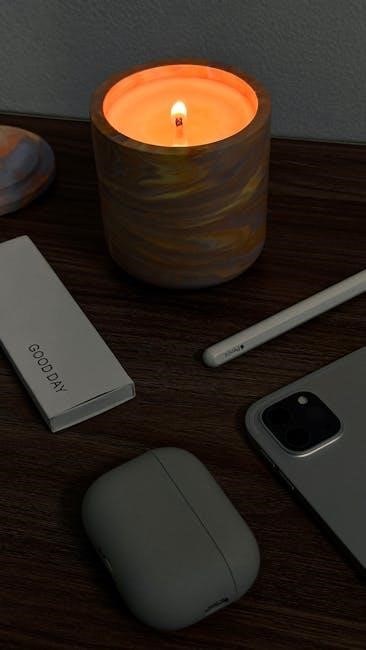Desk stretches are essential for modern workers. Prolonged sitting leads to back pain and stiffness. Regular stretching improves posture, reduces discomfort, and boosts energy. Simple exercises can make a big difference in overall well-being.
1.1 Importance of Desk Stretches in Modern Work Culture
In today’s sedentary work environment, desk stretches are vital for combating health risks linked to prolonged sitting. They reduce muscle tension, improve circulation, and enhance focus, contributing to overall well-being and productivity. Incorporating simple exercises, like neck rolls and spinal twists, can mitigate back pain and stiffness, fostering a healthier work culture.
1.2 Brief Overview of the Topic
Desk stretches are simple exercises designed to alleviate discomfort from prolonged sitting. They target key areas like the neck, shoulders, back, and wrists, improving posture and reducing stiffness. Regular stretching enhances blood flow, boosts energy, and prevents musculoskeletal issues. This guide provides a comprehensive approach to incorporating effective desk stretches into daily routines for better health and productivity.
Why Desk Stretches Are Essential
Desk stretches are vital for countering sedentary work. They reduce back pain, stiffness, and health risks, improving overall well-being and productivity.
2.1 Health Risks of Prolonged Sitting
Prolonged sitting increases the risk of musculoskeletal disorders, back pain, and poor posture. It can lead to muscle tightness, joint strain, and reduced blood circulation, exacerbating overall health issues over time.
2.2 Common Pain Points for Desk Workers
Desk workers often experience lower back pain, neck strain, and shoulder tension due to poor posture. Prolonged sitting can lead to tight muscles, wrist discomfort, and reduced mobility. These issues stem from inadequate ergonomics and lack of movement, highlighting the need for regular stretching to alleviate discomfort and improve overall well-being.
Benefits of Regular Desk Stretching
Regular desk stretching improves posture, reduces back pain, and enhances blood circulation. It boosts energy levels and prevents long-term musculoskeletal issues, promoting overall well-being and productivity.
3.1 Improved Posture and Reduced Back Pain
Desk stretches help maintain proper posture by strengthening core muscles and relieving tension in the neck and shoulders. Regular stretching reduces back pain caused by prolonged sitting, improving spinal alignment and preventing long-term musculoskeletal issues. Simple exercises like shoulder rolls and spinal twists can significantly enhance comfort and reduce stiffness, promoting better overall posture and reducing the risk of back-related discomfort.

3.2 Enhanced Blood Circulation and Energy Levels
Desk stretches promote blood flow, reducing the stagnation caused by prolonged sitting. Improved circulation delivers oxygen and nutrients to muscles, boosting energy levels and mental clarity. Stretching movements like hip flexor stretches and spinal rotations help combat fatigue, leaving you more refreshed and focused throughout the workday.
3.3 Reduced Risk of Musculoskeletal Disorders
Regular desk stretches can significantly lower the risk of musculoskeletal disorders, such as tendonitis and carpal tunnel syndrome. Stretching hip flexors, wrists, and shoulders helps maintain flexibility and strength, preventing repetitive strain injuries. Consistent movement reduces muscle imbalances, promoting long-term joint health and reducing the likelihood of chronic pain or discomfort associated with sedentary work.

Science Behind Desk Stretches
Desk stretches counteract the effects of prolonged sitting by improving blood flow and reducing muscle imbalances. Regular stretching helps restore natural posture and prevents long-term damage.
4.1 How Sitting Affects the Body
Prolonged sitting leads to muscle imbalances, poor posture, and reduced blood flow. It strains the spine, tightens neck and shoulder muscles, and weakens core stability. Over time, this can cause back pain, stiffness, and increased risk of musculoskeletal disorders. Additionally, sitting for hours can lower energy levels and contribute to chronic health issues like poor circulation and heightened stress.
4.2 Role of Stretching in Muscle Recovery
Stretching plays a crucial role in muscle recovery by reducing tension, improving blood flow, and preventing long-term damage. Regular desk stretches help alleviate tightness in the neck, shoulders, and back, common areas affected by prolonged sitting. This promotes relaxation, enhances flexibility, and supports overall musculoskeletal health, making it easier to maintain proper posture and reduce the risk of chronic pain.

Types of Desk Stretches
Desk stretches include exercises targeting the neck, shoulders, back, wrists, hands, hips, and legs. These simple movements help reduce tension and improve flexibility, enhancing comfort.
5.1 Neck and Shoulder Stretches

Neck and shoulder stretches are crucial for relieving tension from prolonged screen time. Roll your neck slowly in both directions to loosen stiffness. Lift shoulders up, hold, and release to reduce tightness. These exercises improve flexibility and prevent strain, enhancing comfort during long work hours. Regular practice helps maintain proper alignment and reduces the risk of musculoskeletal issues.
5.2 Back and Spinal Stretches
Back and spinal stretches are vital for addressing lower back pain caused by prolonged sitting. Gentle spinal rotations and side stretches can alleviate stiffness. Sit tall, twist your torso, and hold for 10 seconds. These exercises improve posture, reduce discomfort, and strengthen core muscles. Regular practice helps prevent long-term musculoskeletal issues and enhances overall spinal flexibility and alignment.
5.3 Wrist and Hand Stretches
Wrist and hand stretches are crucial for desk workers who type or use a mouse frequently. Extend your hand up, then down, and rotate your wrists in both directions. These exercises relieve tension, improve circulation, and prevent conditions like carpal tunnel syndrome. Regular stretching can enhance dexterity and reduce the risk of long-term musculoskeletal issues in the hands and wrists.
5.4 Hip and Leg Stretches
Hip and leg stretches are vital for desk workers to combat prolonged sitting. Try seated leg extensions, hip flexor stretches, and ankle rotations to improve circulation and reduce stiffness. These exercises help prevent tightness in the hips and legs, common issues from sitting for long periods. Regular stretching can enhance mobility and reduce the risk of discomfort or injury in the lower body.

How to Perform Desk Stretches Correctly
Proper technique and breathing are key. Hold stretches 20-30 seconds, avoid bouncing, and focus on gentle movements. Consistency ensures maximum benefits and prevents discomfort.
6.1 Proper Technique for Maximum Benefit
Proper technique ensures safety and effectiveness. Start with gentle movements, avoiding force. Hold stretches for 10-30 seconds to allow muscles to relax. Focus on slow, controlled motions to target specific areas without strain. Maintain steady breathing to enhance relaxation and prevent muscle tension. Avoid bouncing, as it can cause injury. Consistency and mindfulness are key to achieving lasting benefits.
6.2 Breathing and Timing Tips
Deep breathing enhances relaxation and prevents muscle tension. Inhale deeply before stretching, then exhale slowly as you move. Hold stretches for 10-30 seconds to allow muscles to release. Avoid holding your breath, as it can increase tension. Perform stretches every 1-2 hours to maintain flexibility and reduce stiffness. Consistency and mindful breathing ensure optimal benefits from your desk stretching routine.
Frequency and Duration of Desk Stretches
Aim for 5-10 minute stretching sessions every 1-2 hours. Consistency is key to reducing stiffness and improving circulation. Regular breaks prevent prolonged sitting risks effectively.
7.1 Recommended Stretching Schedule
Start with 5-10 minute sessions every 1-2 hours. Incorporate neck rolls, shoulder shrugs, and wrist extensions during breaks. Gradually increase duration as comfort improves. Consistency is key to reducing stiffness and enhancing mobility. Aim for at least 3-4 sessions daily, adjusting based on workload and personal comfort levels. Regular breaks help maintain focus and prevent musculoskeletal strain over time.
7.2 Signs You Need to Stretch More
If you experience persistent back pain, stiffness, or fatigue, it’s a clear sign to stretch more. Poor posture, tight muscles, or difficulty moving after sitting are additional indicators. Increased stress levels or decreased focus can also signal the need for more frequent stretching. Addressing these signs early helps prevent long-term discomfort and promotes overall well-being.
Desk Stretching for Different Needs
Desk stretches cater to office workers, remote employees, and those with injuries. Tailored exercises improve posture, reduce discomfort, and enhance mobility for diverse needs and preferences.
8.1 Stretches for Office Workers
Office workers can benefit from simple stretches like neck rolls, shoulder shrugs, and wrist extensions. These exercises reduce tension from prolonged sitting and improve circulation. Regular stretching breaks can alleviate back pain and enhance focus. Incorporating spinal twists and leg stretches also helps maintain posture and energy levels throughout the workday, promoting overall well-being and productivity.
8.2 Stretches for Remote Workers
Remote workers benefit from stretches tailored to home workspaces. Neck stretches, shoulder rolls, and wrist extensions reduce muscle tension. Spinal twists and leg stretches improve circulation and posture. Regular breaks for stretching can enhance focus and energy, even in non-traditional work environments. Incorporating these exercises into daily routines helps remote workers maintain physical and mental well-being while working from home.
8.3 Modifications for People with Injuries
For individuals with injuries, desk stretches can be adapted to accommodate physical limitations. Consulting a healthcare professional is crucial to ensure safe practices. Gentle movements, such as seated neck stretches or wrist extensions, can be modified to avoid pain. Using props like pillows or resistance bands may also help. Prioritizing injury-specific exercises promotes healing while maintaining mobility and comfort during work hours.

Common Mistakes to Avoid
Overstretching can lead to injury, while ignoring proper form reduces effectiveness. Prioritize gentle, controlled movements and avoid bouncing to ensure safe and beneficial stretching practices.
9.1 Overstretching and Its Consequences
Overstretching can lead to muscle strains, tendon inflammation, and prolonged recovery. It often occurs when individuals push past discomfort or bounce during stretches. This can weaken muscles, reduce flexibility, and cause chronic pain. Prioritizing gentle, controlled movements is crucial to avoid such injuries and maintain long-term benefits from desk stretching routines.
9.2 Ignoring Proper Form
Ignoring proper form during desk stretches can lead to ineffective results and potential injury. Poor posture and incorrect techniques may cause muscle imbalances or worsen existing discomfort. Consistently poor form can also increase the risk of long-term injuries, such as strains or chronic pain. Prioritizing correct alignment and movement is essential for safe and beneficial stretching practices.
Success Stories and Testimonials
Many individuals have reported significant improvements in posture, reduced back pain, and enhanced energy levels after incorporating desk stretches into their daily routines. Testimonials highlight how regular stretching has boosted productivity and overall well-being, encouraging others to adopt these simple yet effective practices for a healthier work life.
10.1 Real-Life Benefits of Desk Stretching
Individuals who practice desk stretching regularly report reduced back pain, improved posture, and increased energy levels. Many testify that these exercises have enhanced their focus and productivity, while others appreciate the stress relief and overall well-being they provide. Real-life stories highlight how simple, consistent stretching can transform daily work routines and promote long-term health benefits.

Combining Desk Stretches with Other Exercises
Integrating desk stretches with yoga or Pilates enhances flexibility and core strength. Adding strength training improves muscle balance, promoting overall physical well-being and workplace vitality effectively.
11.1 Pairing with Yoga or Pilates
Combining desk stretches with yoga or Pilates enhances flexibility and strength. These practices improve posture, reduce muscle tension, and boost circulation. Incorporating poses like child’s pose or downward dog can deepen relaxation and rejuvenation, making desk stretches more effective for overall well-being.
11.2 Incorporating Strength Training
Incorporating strength training into your routine complements desk stretches by building muscle endurance and stability. Exercises like squats, planks, and lunges target core and leg muscles, essential for desk workers. Strengthening these areas improves posture, reduces injury risk, and enhances the effectiveness of stretching routines, promoting long-term physical health and productivity.
Creating a Desk Stretching Routine
A well-structured desk stretching routine includes neck rolls, shoulder lifts, and spinal twists. Perform these exercises every hour to maintain flexibility and reduce stiffness effectively.
12.1 Customizing a Routine for Your Needs
Assess your specific discomfort areas and goals to tailor a stretching routine. Incorporate exercises targeting neck, shoulders, and back. Start with simple stretches like neck rolls or spinal twists, adjusting frequency and duration as needed. Consistency is key to achieving long-term benefits and preventing musculoskeletal issues. Make adjustments based on progress and comfort levels.
12.2 Tracking Progress and Consistency
Use a journal or app to log your stretching routine and monitor improvements. Celebrate small milestones to stay motivated. Adjust your schedule as needed to maintain consistency. Regular tracking helps identify patterns and ensures long-term commitment. Over time, this discipline fosters healthier habits and reduces the risk of musculoskeletal issues, promoting overall well-being.

Desk Stretching PDF Guide
A comprehensive Desk Stretching PDF Guide offers detailed routines, visual aids, and step-by-step instructions. It helps create a personalized plan, improving posture and reducing discomfort through regular stretching.
13.1 What to Include in a Comprehensive Guide
A comprehensive guide should include detailed stretching exercises, visual aids, and step-by-step instructions. It should cover benefits, proper techniques, and customization options. Also, address common mistakes and provide tracking methods for consistency. This ensures a well-rounded resource for improving posture, reducing discomfort, and enhancing overall well-being through regular desk stretching routines.
13.2 Visual Aids and Instructions
Include high-quality images, diagrams, and clear step-by-step instructions for each stretch. Visual aids help users understand proper form and technique. Detailed descriptions ensure exercises are performed safely and effectively. This combination makes the guide user-friendly and accessible, even for those new to desk stretching.
Sharing and Promoting the PDF
Share the desk stretches guide in workplaces and on social media to promote health awareness. Encourage colleagues and followers to adopt stretching routines for better well-being and productivity.
14.1 Distributing the Guide in the Workplace
Distribute the desk stretches PDF via email or print copies for employees. Share during meetings or wellness programs to promote health. Encourage managers to support stretching breaks, fostering a culture of well-being. Highlight the benefits of regular stretching to reduce discomfort and boost productivity, ensuring everyone can access and utilize the guide effectively.
14.2 Using Social Media for Awareness
Share the desk stretches PDF on platforms like Instagram, Twitter, and LinkedIn. Create engaging posts with infographics, videos, or testimonials. Use hashtags like #DeskStretching or #WorkplaceWellness to reach a wider audience. Encourage employees to share their stretching routines and benefits, fostering a community of health-conscious individuals. This approach can inspire others to adopt regular stretching habits and improve their well-being.

Conclusion
Desk stretches are a simple yet powerful tool for improving posture, reducing pain, and enhancing overall well-being. Start your stretching routine today for a healthier tomorrow!
15.1 Final Thoughts on Desk Stretching
Desk stretches are essential for modern workers. Prolonged sitting leads to back pain and stiffness. Regular stretching improves posture, reduces discomfort, and boosts energy. Simple exercises can make a big difference in overall well-being. Start your stretching routine today for a healthier tomorrow!
15.2 Encouragement to Start Stretching
Starting a desk stretching routine is easier than you think! Even a few minutes a day can make a significant difference. Begin with simple exercises to loosen tight muscles and improve posture. Remember, consistency is key. Take the first step today and embrace a healthier, happier you. Your body will thank you!